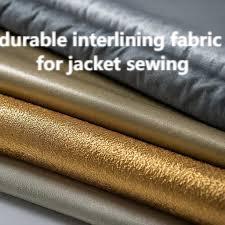In contemporary apparel design, the role of Interlining is crucial for achieving structure, comfort, and longevity in garments. By positioning a supportive layer between outer fabrics and linings, designers can control drape, reinforce seams, and enhance thermal regulation without adding bulk. Properly selected interlining materials enable apparel to retain its shape, withstand frequent laundering, and deliver consistent performance across seasons.
Purpose and Functional Benefits
A supportive layer contributes to garment stability in key areas such as collars, cuffs, and waistbands. By reinforcing these zones, tailoring maintains crisp lines and prevents fabric distortion over time. Beyond structure, this hidden layer can improve wearer comfort by adding slight cushioning, reducing friction between skin and outer fabric. In performance wear, it can optimize moisture management, helping regulate body temperature during high‑intensity activities.
Material Selection and Customization
Choices range from lightweight non‑woven textiles to heavier woven canvases, each offering distinct hand and performance attributes. Thermally activated adhesives allow seamless bonding without visible stitching, while sew‑in variants permit greater flexibility in bespoke tailoring. Stretchable formulations support activewear by accommodating movement without compromising garment integrity. Working with specialty suppliers, designers specify fiber blends, weights, and adhesive strengths to meet unique end‑use conditions and aesthetic goals.
Integration into Garment Construction
Efficient application methods are vital for high‑volume manufacturing. Fusible versions adhere under controlled heat and pressure, reducing manual steps and ensuring consistent results. Pre‑cut interlining sheets streamline automated cutting and placement, minimizing material waste and speeding assembly. For couture or tailored pieces, hand‑attached options permit precise alignment and adjustment. Quality control measures—such as peel strength testing—verify bond integrity before garments reach the finished‑goods stage.
Interlining-Factory’s Advanced Bonding Techniques
Cutting‑edge bonding technologies enhance adhesion uniformity and reduce processing time. Low‑temperature adhesives accommodate delicate fabrics, while thermally reversible bonds enable rework without damage. Ultrasonic bonding systems eliminate liquid adhesives altogether, creating eco‑friendly, solvent‑free assemblies. These innovations facilitate seamless integration with digital cutting and pressing equipment, making production more agile and responsive to design changes.
Environmental and Sustainability Considerations
As the textile industry embraces greener practices, support layers are evolving to include recycled and bio‑based fibers. Water‑soluble adhesives permit garment recycling by allowing easy separation of layers. Non‑toxic binder systems reduce chemical footprints while maintaining performance standards. Lifecycle assessments guide material choices, helping brands meet eco‑certifications and consumer expectations for responsible sourcing.
Overall, the strategic use of support layers elevates garment quality, ensuring pieces look and feel premium from first wear through years of use. Whether in high‑fashion tailoring or mass‑market athleisure, these hidden components play an outsized role in user satisfaction and brand reputation. To explore detailed applications, types, and technical insights, visit https://www.interlining‑factory.com/news/what-is-interlining-types-applications-and-more.html



